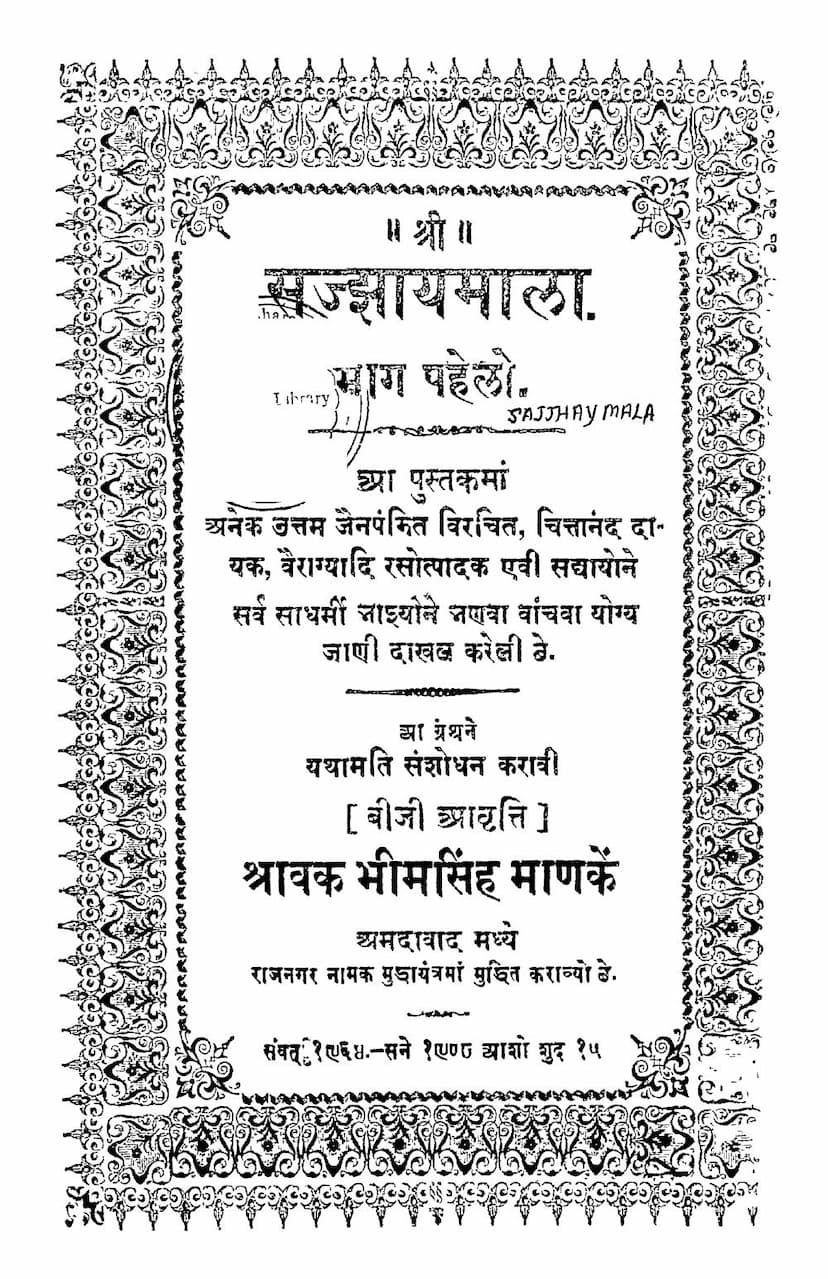Sazzayamala
Added to library: September 2, 2025

Summary
Sajjhyamala by Shravak Bhimsinh Manek: A Comprehensive Summary
Sajjhyamala (सज्झायमाला), compiled by Shravak Bhimsinh Manek, is a significant Jain text intended for the edification and spiritual upliftment of all followers of Jainism. Published in Ahmedabad, this collection aims to provide solace and inspire detachment from worldly affairs through a compilation of devotional songs and narratives (sajjhayas) composed by various esteemed Jain scholars. The text emphasizes devotion (bhakti) and renunciation (vairagya), aiming to bring joy and spiritual understanding to the hearts of its readers.
Key aspects of Sajjhyamala:
- Purpose and Audience: The book is designed to be accessible to all Jains, including monks, nuns, and laypeople. It seeks to foster devotion and renunciation by presenting spiritual themes in a melodious and engaging manner. The author notes that while many Jain texts exist in Sanskrit or Prakrit, which require deep understanding and guidance, Sajjhyamala is written in a language that is easily understandable by anyone.
- Content: Sajjhyamala is a collection of "sajjhayas," which are devotional songs or poems often set to traditional melodies (dhals). These songs explore various aspects of Jain philosophy and practice, including:
- Devotion to Tirthankaras and Jain principles: Many songs are dedicated to praising the Tirthankaras, their teachings, and the core tenets of Jainism like karma, soul, and liberation.
- Ethical conduct and virtues: The text delves into the importance of virtues like non-violence (ahimsa), truthfulness (satya), non-stealing (asteya), celibacy (brahmacharya), non-possession (aparigraha), forgiveness (kshama), humility (vinaya), contentment (santosha), and self-control (samyam).
- Renunciation and detachment: A significant portion of the collection focuses on the impermanence of worldly possessions, relationships, and life itself, encouraging detachment and the pursuit of spiritual liberation.
- Moral lessons and stories: Many säjjhayas recount stories of past saints, kings, queens, and ordinary individuals who exemplified Jain virtues or faced consequences for their actions, serving as moral exemplars and cautionary tales. Examples include stories of various Munis, Munis, Satis (virtuous women) like Sita, Rajulmati, and Chandana, as well as tales of kings like Neminath, King Srenik, and King Bharat.
- Philosophical concepts: The text touches upon key Jain philosophical ideas such as the nature of the soul, karma, rebirth, the path to liberation, and the importance of the Three Jewels (Samyak Darshan, Samyak Gyan, Samyak Charitra).
- Daily practices: Some songs might allude to or explain the significance of Jain practices like fasting (tapas), equanimity (samayika), meditation (dhyana), and the importance of ethical behavior in daily life.
- Language and Style: The Sajjhyamala is written in Gujarati, making it accessible to a wider audience. The songs are composed in a devotional and often poetic style, designed to evoke emotional resonance and spiritual contemplation. The use of traditional melodies (dhals) further enhances its appeal and memorability.
- Structure: The book is organized with a detailed index (Anukramanika) listing the various Sajjhayas by title, along with their first line and the page number. This structure allows readers to easily navigate through the diverse collection of songs. The text includes an introduction (Prastavana) and concludes with a section on questions and answers (Prashnottar Vakyaratna Sangraha), providing further insights into Jain ethics and philosophy.
- Second Edition: The provided text refers to the "second edition" of Sajjhyamala, indicating its popularity and the demand for more copies. The author, Shravak Bhimsinh Manek, also mentions the efforts made in revising and enhancing the collection with additional devotional pieces.
In essence, Sajjhyamala is a treasure trove of devotional literature that aims to guide individuals towards a life of piety, virtue, and detachment, ultimately leading them to the path of spiritual liberation according to Jain principles.